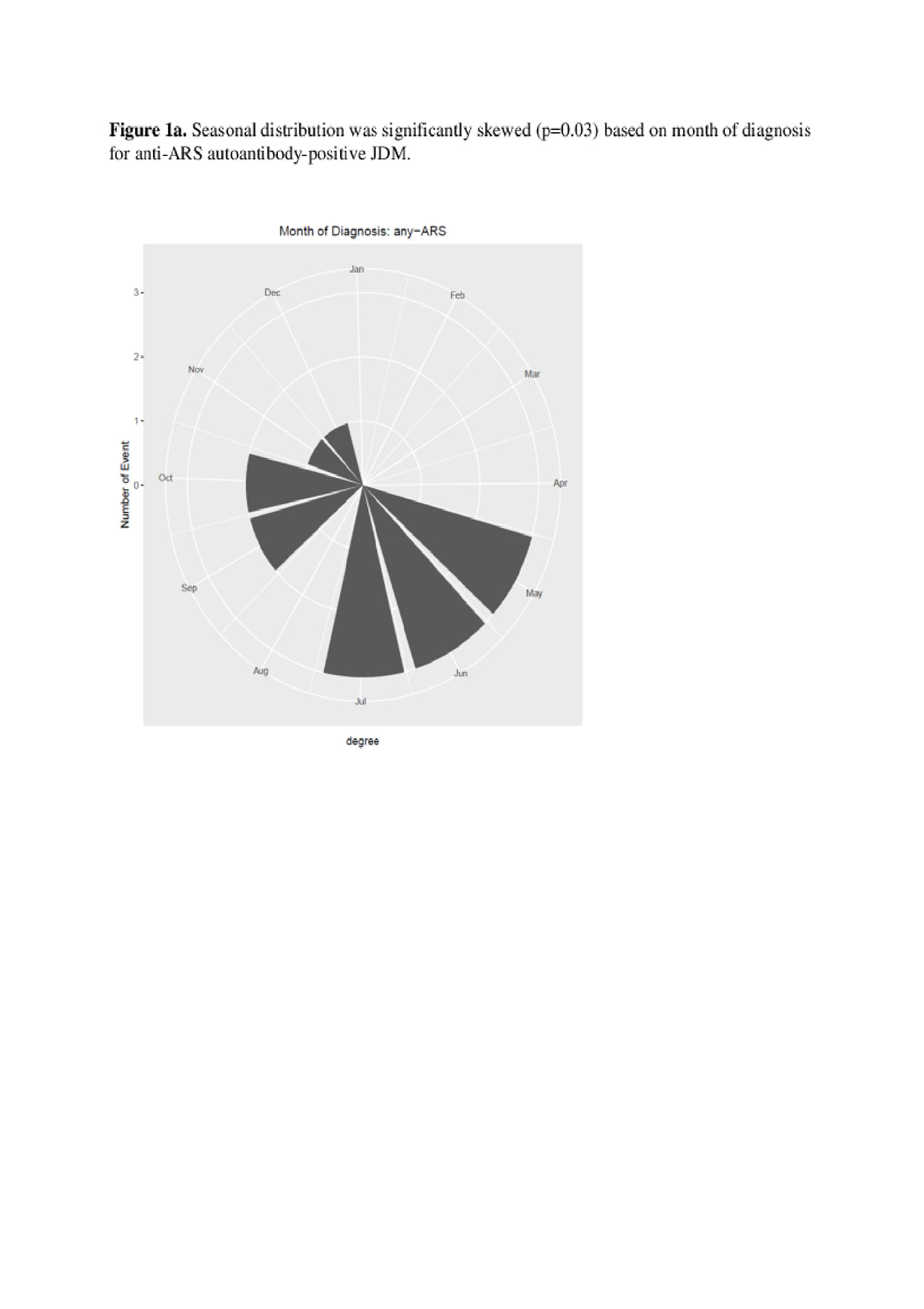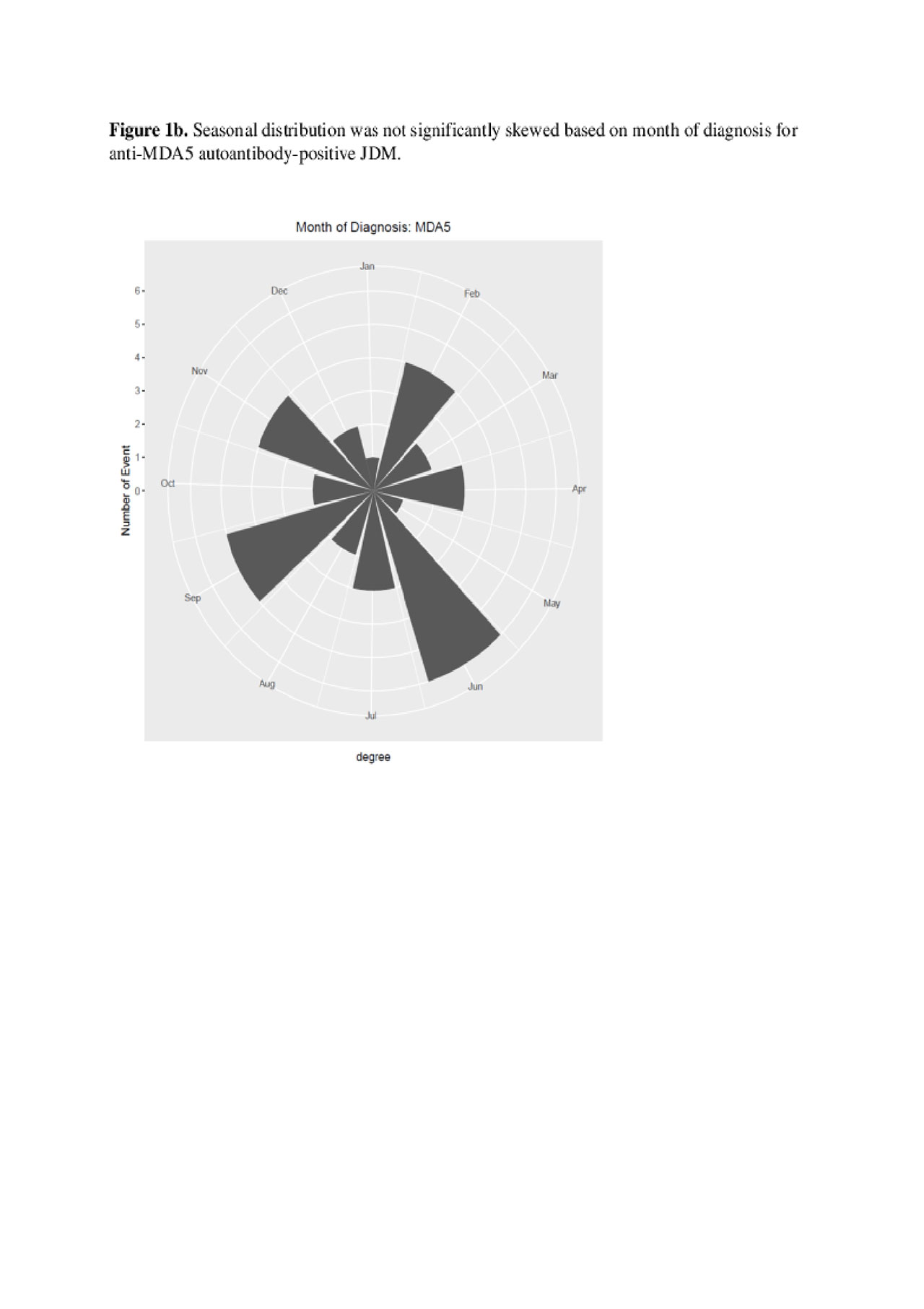Session Information
Session Type: Poster Session (Sunday)
Session Time: 9:00AM-11:00AM
Background/Purpose: Published studies suggest seasonal occurrence of disease onset and disease activity in patients with adult idiopathic inflammatory myopathies (IIM).Our objective was to evaluate seasonal variation of disease onset and diagnosis and the distribution over time of myositis autoantibodies in JDM.
Methods: This study includes disease onset and diagnosis data of 383 myositis patients enrolled in NIH studies from 1994 to 2015. We tested myositis-specific autoantibodies (MSA) by standard immunoprecipitation (IP) and IP-immunoblotting methods and identified five autoantibody subtypes: 35 patients with JDM diagnosed before age 18 years with anti-melanoma-differentiation gene 5 (MDA5) autoantibodies, 157 with anti- transcriptional intermediary factor 1 (TIF1), 116 with anti-nuclear matrix protein 2 (NXP2), 15 with anti-synthetase (ARS) autoantibodies and 60 MSA-negative JDM patients, all meeting probable or definite Bohan and Peter criteria. We studied overall seasonable patterns of disease onset and diagnosis dates (by month) and performed comparisons between autoantibody subtypes. Circular statistics were used with seasonality and differences between the groups assessed by the Rayleigh test and Watson two sample test for homogeneity, respectively. Proportion trend test was used to assess the trend of anti-MDA5 Ab over time compared to anti-TIF1 and anti-NXP2 autoantibodies.
Results: There was no seasonal clustering of the month of disease onset in JDM patients as a whole nor in the anti-ARS, anti-MDA5, anti-TIF1, anti-NXP2 autoantibody-positive and MSA-negative JDM subgroups. Anti-ARS autoantibody positive JDM patients had a seasonal pattern of disease diagnosis, with a peak time of diagnosis from May to July, and no patients with anti-ARS autoantibodies were diagnosed from January to April (p=0.03, Figure 1a). There were no differences in the seasonal patterns of disease onset and disease diagnosis of anti-MDA5 autoantibody-positive JDM patients compared to anti-TIF1 and anti-NXP2 autoantibody-positive, and MSA-negative patients (p >0.1, Figure 1b). In examining temporal trend of anti-MDA5 autoantibodies compared to anti-TIF1 and anti-NXP2 autoantibodies over time, from 1988 to 2015, we found no significant differences in the trend of occurrence of these subgroups based on year of symptom onset or of diagnosis (p >0.2).
Conclusion: Similar to adult IIM patients, JDM patients with anti-ARS autoantibodies demonstrate a spring to early summer seasonal peak in diagnosis, suggestive of certain environmental factors contributing to illness onset in these patients. In contrast, other MSA groups, including anti-MDA5, anti-TIF1, anti-NXP2 autoantibodies and MSA-negative JDM groups, did not exhibit seasonality in onset or diagnosis. In contrast to non-US cohorts, the frequency of anti-MDA5 autoantibodies has not increased over the past three decades and did not differ compared to anti-TIF1 and anti-NXP2 autoantibody-positive groups.
To cite this abstract in AMA style:
Mamyrova G, Shi M, Targoff I, Curiel R, Miller F, Rider L. Seasonal and Temporal Analyses of Disease Onset and Diagnosis in Myositis Autoantibody Phenotypes in Juvenile Dermatomyositis (JDM) [abstract]. Arthritis Rheumatol. 2019; 71 (suppl 10). https://acrabstracts.org/abstract/seasonal-and-temporal-analyses-of-disease-onset-and-diagnosis-in-myositis-autoantibody-phenotypes-in-juvenile-dermatomyositis-jdm/. Accessed .« Back to 2019 ACR/ARP Annual Meeting
ACR Meeting Abstracts - https://acrabstracts.org/abstract/seasonal-and-temporal-analyses-of-disease-onset-and-diagnosis-in-myositis-autoantibody-phenotypes-in-juvenile-dermatomyositis-jdm/


